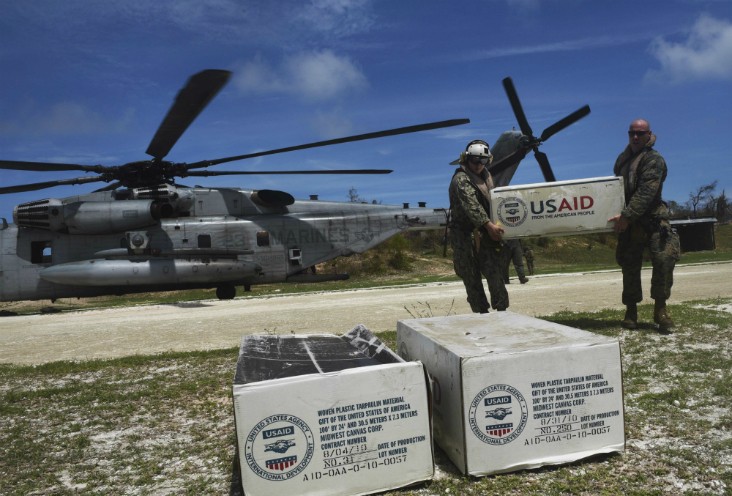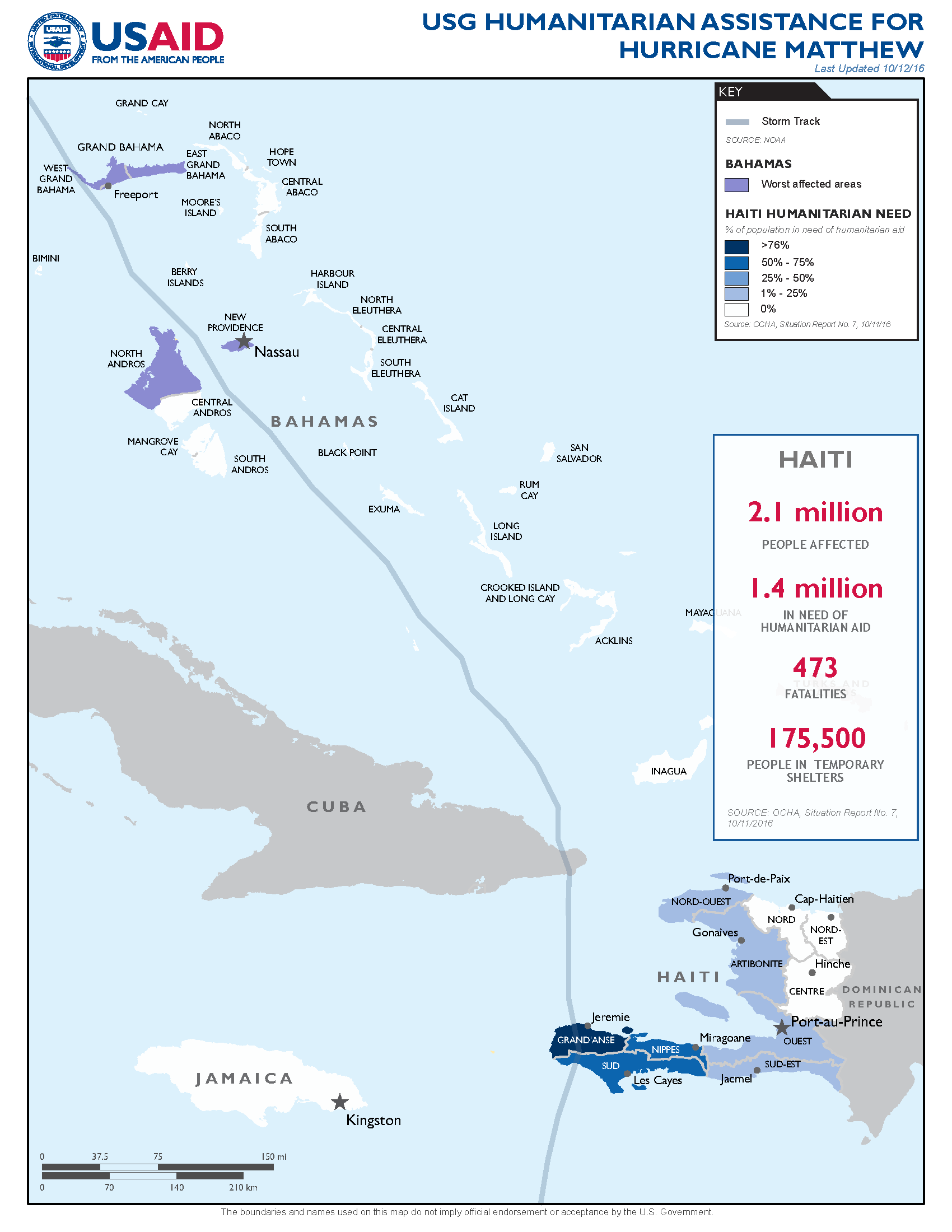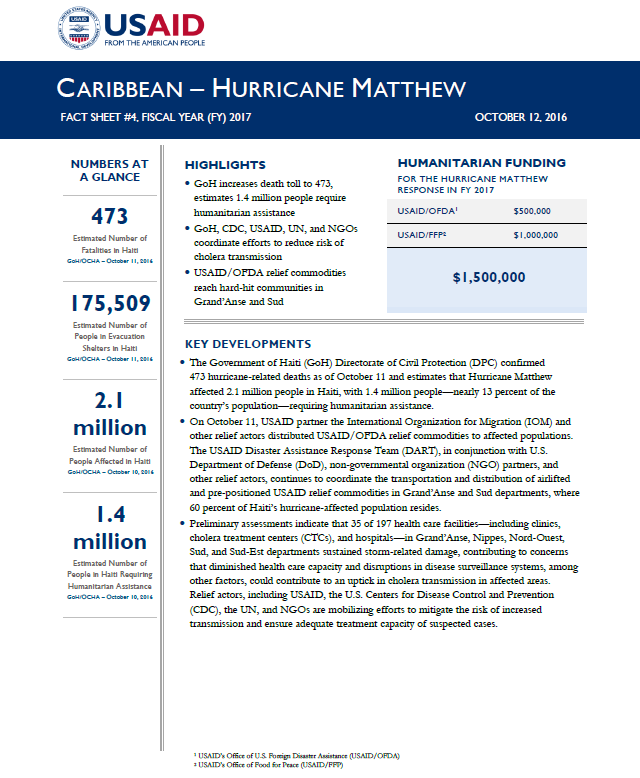Speeches Shim

October 12, 2016
Highlights
Government of Haiti (GoH) increases death toll to 473, estimates 1.4 million people require humanitarian assistance
GoH, CDC, USAID, UN, and NGOs coordinate efforts to reduce risk of cholera transmission
USAID/OFDA relief commodities reach hard-hit communities in Grand’Anse and Sud
Key Developments
Numbers At A Glance
473
175,509
2.1 million
1.4 million
Humanitarian Funding
For the Hurricane Matthew Response
in FY 2017
| USAID/OFDA | $500,000 |
| USAID/FFP | $1,000,000 |
| TOTAL | $1,500,000 |
The Government of Haiti (GoH) Directorate of Civil Protection (DPC) confirmed 473 hurricane-related deaths as of October 11 and estimates that Hurricane Matthew affected 2.1 million people in Haiti, with 1.4 million people—nearly 13 percent of the country’s population—requiring humanitarian assistance.
On October 11, USAID partner the International Organization for Migration (IOM) and other relief actors distributed USAID/OFDA relief commodities to affected populations. The USAID Disaster Assistance Response Team (DART), in conjunction with U.S. Department of Defense (DoD), non-governmental organization (NGO) partners, and other relief actors, continues to coordinate the transportation and distribution of airlifted and pre-positioned USAID relief commodities in Grand’Anse and Sud departments, where 60 percent of Haiti’s hurricane-affected population resides.
Preliminary assessments indicate that 35 of 197 health care facilities—including clinics, cholera treatment centers (CTCs), and hospitals—in Grand’Anse, Nippes, Nord-Ouest, Sud, and Sud-Est departments sustained storm-related damage, contributing to concerns that diminished health care capacity and disruptions in disease surveillance systems, among other factors, could contribute to an uptick in cholera transmission in affected areas. Relief actors, including USAID, the U.S. Centers for Disease Control and Prevention (CDC), the UN, and NGOs are mobilizing efforts to mitigate the risk of increased transmission and ensure adequate treatment capacity of suspected cases.
LOGISTICS SUPPORT AND RELIEF COMMODITIES
Many communes in Grand’Anse, including Jeremie, are now accessible to relief actors; however, the majority of communes in Sud, including Les Anglais commune, are still inaccessible via road, according to the global Logistics Cluster—the coordinating body for humanitarian logistics activities, comprising UN agencies, NGOs, and other stakeholders. USAID/OFDA is working in partnership with the GoH, DoD, UN organizations, and NGOs to address logistical challenges, bolster humanitarian coordination capacity, and facilitate the delivery of emergency relief commodities to affected populations.
On October 11, a fifth cargo flight transporting USAID/OFDA relief commodities arrived in Haiti. Since October 8, USAID/OFDA has provided more than 480 metric tons (MT) of emergency commodities—including blankets, hygiene kits, kitchen sets, and plastic sheeting—to assist an estimated 100,000 hurricane-affected people.
As of October 10, USAID/OFDA had transferred nearly 27,500 blankets, 17,400 family-size hygiene kits, 10,400 kitchen sets, and 1,600 rolls of plastic sheeting to IOM warehouses for onward distribution to hard-hit communities in Jeremie and Sud’s Les Cayes commune. USAID/OFDA partner Catholic Relief Services (CRS) and the Agency for Technical Cooperation and Development (ACTED) are distributing the relief commodities.
As of October 11, DoD, at the direction of the DART, transported more than 80 MT of relief supplies—including food, generators, hygiene kits, and plastic sheeting—via DoD helicopters from Port-au-Prince to hard-to-reach areas in Grand’Anse and Sud, including Les Anglais. To date, DoD has transported 116 MT of humanitarian supplies to affected communities in Haiti.
On October 11, DART-coordinated DoD helicopter relief flights delivered 70 UN World Health Organization (WHO)-supplied cholera treatment beds to Les Cayes. DoD helicopters also delivered beans, cooking oil, and rice, as well as USAID/OFDA-supplied hygiene kits and rolls of plastic sheeting, to Dame-Marie, where local NGO Mission of Hope Haiti will facilitate the distribution of the relief supplies in the coming days.
IOM, with USAID/OFDA support, had distributed emergency relief supplies estimated to benefit more than 100 households in Grand’Anse, as of October 11. IOM also provided Mission of Hope Haiti with 5,500 USAID/OFDA-supplied family-sized hygiene kits; the NGO plans to deliver the kits to hurricane-affected people in Grand’Anse’s Bonbon and Abricot communes. Additionally, CRS has distributed cooking materials, emergency food assistance, and hygiene kits to approximately 500 families in Sud, with USAID/OFDA support.
The DART is also coordinating response efforts with the Government of the Commonwealth of The Bahamas (GCoB), particularly in the worst-affected islands of Grand Bahama, New Providence, and northern Andros. In a press conference on October 9, GCoB reported that damage assessments, as well as activities to clear roads and restore electricity, remained ongoing. Both the National Emergency Management Agency and the Royal Bahamas Police Force have provided relief supplies, including water, canned goods, and generators, to hurricane-affected populations in Andros. On October 12, a USAID/OFDA-supported airlift arrived in The Bahamas with relief supplies, including generators and hygiene kits.
HEALTH AND WASH
Health actors continue to express concern that hurricane-related impacts—including damage to health and water infrastructure, diminished health care service capacity, and disruptions to disease surveillance systems—may increase the risk of cholera transmission in affected areas of Haiti. From October 2–8, health care workers identified approximately 200 suspected cholera cases in Grand’Anse and Sud, where health care personnel reported approximately 160 suspected cases during the month of August. Relief actors, including the U.S. Centers for Disease Control and Prevention (CDC), caution that the extent to which the suspected cases identified in recent days represent an increase above normal levels remains unclear due to inconsistent reporting prior to the hurricane and disruptions in regular reporting and surveillance systems since. CDC also notes that suspected cholera cases reported to date in 2016 are somewhat higher than 2014/2015 levels and that instances of cholera regularly peak late in the year due to increased rainfall levels. Cholera—a waterborne illness that can cause severe diarrhea and dehydration—has been endemic in Haiti since 2010. Haiti has reported nearly 800,000 cholera cases since the initial outbreak, including an estimated 9,300 resulting deaths, according to WHO.
CDC is working to assess and strengthen disease surveillance and monitoring capacity, in coordination with the GoH Ministry of Health and Population (MSPP) and other relief actors. On October 12, CDC dispatched staff to conduct assessments of health care facilities located in affected areas. CDC is also providing communications equipment and laboratory supplies—including rapid diagnostic tests for cholera, specimen collection and transportation kits, and additional supplies to support the testing of antibiotic and culture samples at the GoH National Public Health Laboratory—to support cholera mitigation and response efforts in Haiti. The MSPP and Pan-American Health Organization (PAHO) have also initiated the implementation of a disease early warning system in Sud. The system is collecting information through community- and shelter-based surveillance techniques, as well as routine surveillance conducted in health facilities that remain operational following Hurricane Matthew. CDC plans to support an expansion of the system, beginning in Grand’Anse, while also helping to ensure the National Cholera Surveillance System resumes operations in hard-hit areas.
The International Medical Corps is providing primary and secondary health care services, including treating mild suspected cases of cholera, in Sud’s Chardonnieres commune, reaching an estimated 200 people through its mobile health clinic program as of October 11. Other relief actors, including ACTED, Oxfam, the UN Children’s Fund (UNICEF), and WHO, are coordinating with the MSPP to provide medical supplies for cholera treatment, rehabilitate CTCs, and conduct hygiene promotion interventions, among other activities.
To help prevent possible cholera cases in the aftermath of Hurricane Matthew, the DART is prioritizing the delivery of chlorine, hygiene kits, water purification tablets, and other water, sanitation, and health (WASH) supplies to hard-hit areas in southwestern Haiti. USAID/OFDA has deployed public health and WASH advisors to support these activities and facilitate coordination with the MSPP, CDC, and other relief actors.
An estimated 750,000 people require WASH assistance in Haiti, including nearly 30,000 people in Jeremie who lack access to safe drinking water due to water infrastructure damage and water contamination from sewage overflow, according to the UN Office for the Coordination of Humanitarian Affairs (OCHA). As of October 10, UNICEF, in partnership with ACTED and Oxfam, had delivered pre-positioned emergency supplies—including water purification tablets—to an estimated 10,000 people in Grand’Anse and Sud. In addition, UNICEF is providing calcium hypochlorite stock for routine water chlorination, water purification tablets, and water storage buckets to meet the needs of approximately 40,000 people in Grand’Anse and Sud for two weeks. UNICEF is also supporting the GoH National Directorate for Water and Sanitation (DINEPA) and the Government of France Civil Protection to install water treatment units in Jeremie to improve the commune’s access to potable water. NGO CARE has also collaborated with DINEPA in recent days to establish two water stations in Jeremie to increase access to safe drinking water.
DISPLACEMENT, PROTECTION, AND SHELTER
On October 11, the DPC reported that Hurricane Matthew had displaced approximately 175,500 people to more than 220 temporary shelters countrywide. A recent assessment conducted by USAID/OFDA partner the American Red Cross (AmCross) and the Haiti Red Cross Society (HRCS) in Sud’s Arniquet commune found that the hurricane affected more than 2,000 households, caused extensive damage to water infrastructure in the area, and destroyed approximately 1,000 houses. A joint AmCross–HRCS team coordinated with the DPC to assess three areas of Mole Saint Nicholas commune, Nord-Ouest, where findings indicate the hurricane affected approximately 1,230 households; caused significant damage to crops, sanitation facilities, one hospital, and destroyed nearly 290 houses.
On October 9, UNICEF reported several protection-related concerns, including the high number of female-headed households and the need for family-tracing and reunification activities for children placed at shelters by caregivers due to poverty in Haiti. UNICEF is advocating with NGO partners to increase child protection and gender-based violence response activities, as well as to monitor child trafficking. USAID/OFDA has deployed a protection officer to the DART to provide technical expertise and recommendations for addressing protection concerns.
During a meeting with DART staff during the week of October 10, Save the Children representatives emphasized protection risks associated with continued displacement in GoH shelters, particularly where food and safe drinking water are limited, and with children displaced from residential care centers. Many public schools in Haiti are being used to shelter displaced families, according to UNICEF. Save the Children is deploying more than 10 staff, as well as child protection, emergency health, and shelter advisors, to bolster assistance operations in 27 schools countrywide.
FOOD SECURITY AND NUTRITION
According to OCHA, an estimated 750,000 people in Haiti require urgent food, nutrition, and emergency agricultural assistance for the next three months; 47 percent of the population in need resides in rural areas where Hurricane Matthew destroyed agricultural livelihoods. OCHA notes that Hurricane Matthew struck Haiti during the country’s second main harvest season, resulting in significant damage to crops; the combination of reduced supply, access constraints, and high demand for food items could increase food prices and contribute to deteriorating food security and nutrition conditions. Preliminary findings from a UN World Food Program (WFP) emergency food security assessment indicate that the hurricane destroyed nearly 100 percent of crops in parts of Grand’Anse and up to 90 percent of crops in parts of Sud.
To address food and nutrition needs, USAID/FFP is supporting relief actors, including WFP, to provide food assistance to affected communities in Haiti. With $1 million in USAID/FFP funding NGO CARE has provided nearly 32,500 hot meals in GoH shelters in Grand’Anse, Nippes, Nord-Ouest, and Sud.
FOOD SECURITY
In coordination with the GoH and the UN Food and Agricultural Organization, USAID/FFP partner WFP is conducting emergency food security assessments in the departments of Grand’Anse, Nord-Ouest, Sud, and Sud-Est and reports up to 95 percent harvest loss in some coastal areas.
On October 8, WFP transported approximately 114 metric tons (MT) of emergency food assistance—including pulses, oil, and rice—to severely affected communities in Les Cayes and Jeremie. WFP transported approximately 100 MT to Les Cayes via an overland route, while the DART coordinated the delivery of 14 MT of WFP-procured emergency food assistance via DoD helicopter rotations. WFP plans to airlift approximately 20 MT of High Energy Biscuits from its warehouse in Dubai, United Arab Emirates, in the coming days.
OTHER HUMANITARIAN ASSISTANCE
On October 10, OCHA, in close coordination with the GoH, released a flash appeal in response to Hurricane Matthew’s impacts in Haiti, requesting $119 million to respond to the most urgent humanitarian needs of 750,000 people, including 315,000 children. The flash appeal addresses other sectoral needs, including, food and agriculture needs, logistics, education, health, protection, shelter and relief items, WASH as well as early recovery and livelihoods needs. OCHA also emphasizes the importance of tracking population movement and displaced populations; the appeal includes $1.5 million to establish a Displacement Tracking Matrix, managed by IOM. The October flash appeal is in addition to the 2016 Haiti Humanitarian Response Plan, launched in early 2016 and requesting $193.8 million.
OCHA released $5 million through the Central Emergency Response Fund—a pooled humanitarian fund established and managed by the UN to support sudden-onset and underfunded emergencies—on October 7 to address the most life-saving needs of people affected by Hurricane Matthew; separately OCHA also provided $8 million to UNICEF to bolster its cholera response in the country.
WFP is distributing approximately 3,450 MT of pre-positioned food to affected communities in Haiti through partnerships with NGOs CRS, Fondation pour le Développement et l’Encadrement de la Famille Haïtienne, and HRCS, according to OCHA. Since October 7, WFP has transported approximately 430 MT of food to Jeremie and Les Cayes.
The Japan International Cooperation Agency provided emergency relief supplies—including 1,000 blankets, 600 jerry cans, 100 plastic sheeting rolls, 1,020 sleeping pads, 100 tents, 30 water purifiers, and 10 water tanks—to the DPC on October 11, with forward distribution to affected communities forthcoming.
CONTEXT
Hurricane Matthew made an initial landfall near Haiti’s Les Anglais commune, Sud Department, on October 4, before making a secondary landfall over eastern Cuba on October 4 and continuing to traverse The Bahamas from October 5–6. The storm brought destructive winds, heavy rainfall, and dangerous storm surge, resulting in extensive damage to crops, houses, and infrastructure, as well as widespread flooding in some areas.
On October 2, U.S. Ambassador to Haiti Peter F. Mulrean and U.S. Chargé d’Affaires, a.i., for Jamaica Eric Khant issued disaster declarations in response to the anticipated effects of Hurricane Matthew in Haiti and Jamaica, respectively. U.S. Chargé d’Affaires, a.i., Lisa A. Johnson issued a disaster declaration in response to the anticipated effects of Hurricane Matthew in The Bahamas on October 3.
USAID activated a regional DART on October 3 with staff in The Bahamas, Haiti, and Jamaica. In addition, USAID stood up a Washington, D.C.-based RMT to coordinate the regional humanitarian response.



Comment
Make a general inquiry or suggest an improvement.